Eccentric Compression Properties of FRP–Concrete–Steel Double-Skin Square Tubular Columns
Abstract
1. Introduction
2. Experiment
2.1. Materials and Specimen Design
2.2. Specimen Preparation
2.3. Test Procedure
3. Test Results and Discussion
3.1. Failure Mode
3.2. Evolution of Axial Strain along the Cross-Section
3.3. Axial Bearing Capacity
3.4. Axial Load–Lateral Mid-Span Deflection Curve
3.5. Evolution of Lateral Deflection Curve along the Height of Columns
4. Conclusions
- (1)
- Under eccentric loading, the axial strain of the cross-section at the intermedial height of columns presents a nearly linear development along different distances from the center line, especially in the initial loading stage;
- (2)
- The axial compression bearing capacity of columns with large eccentricity is small. With the increase in axial FRP cloth on the tension side, the corresponding ultimate bearing capacity tends to increase gradually;
- (3)
- When eccentricity is small (e = 5 mm), the axial load–lateral deflection curve of columns is similar to that of axial compression. When eccentricity is large (e = 15, 30 and 45 mm), the development of the axial load–lateral deflection curve is similar. Additionally, their area under the curve decreases gradually, which indicates that the ability to absorb energy declines correspondingly. Therefore, the axial FRP cloth on the tension side can well prevent growing lateral deflection;
- (4)
- Based on the test results and analysis, two suggestions for the structural design and testing method are provided as follows: (1) two-way FRP cloth can be used for the reinforcement of columns, especially for the reinforcement of the tension side of columns under eccentric loading; (2) in order to fully utilize the performance of FCSST columns and avoid local premature failure, the two ends (top and bottom) of the column should be reinforced by FRP cloth before testing.
Author Contributions
Funding
Institutional Review Board Statement
Informed Consent Statement
Data Availability Statement
Conflicts of Interest
References
- Tao, Z.; Han, L.; Huang, H. Concrete-filled double skin steel tubular column with square section under eccentric loads. China Civ. Eng. J. 2003, 36, 33–40. [Google Scholar]
- Tao, Z.; Han, L.; Zhao, X. Behavior of concrete-filled double skin (CHS inner and CHS outer) steel tubular stub columns and beam-columns. J. Constr. Steel Res. 2004, 60, 1129–1158. [Google Scholar] [CrossRef]
- Huang, H.; Tao, Z.; Han, L. Mechanism of concrete-filled double-skin steel tubular columns (CHS inner and CHS outer) subjected to axial compression. Ind. Constr. 2006, 36, 11–14. [Google Scholar]
- Teng, J.G.; Yu, T.; Wong, Y.L.; Dong, S.L. Hybrid FRP-concrete-steel tubular columns: Concept and behavior. Constr. Build. Mater. 2007, 21, 846–854. [Google Scholar] [CrossRef]
- Yu, T.; Wong, Y.; Teng, J. Behavior of Hybrid FRP-Concrete-Steel Double-Skin Tubular Columns Subjected to Eccentric Compression. Adv. Struct. Eng. 2010, 13, 961–974. [Google Scholar] [CrossRef]
- Yu, T.; Zhang, B.; Cao, Y.B.; Teng, J.G. Behavior of hybrid FRP-concrete-steel double-skin tubular columns subjected to cyclic axial compression. Thin Wall Struct. 2012, 61, 196–203. [Google Scholar] [CrossRef]
- Qian, J.; Liu, M. Experimental investigation of FRP-concrete-steel double-skin tubular stubs under axial compressive loading. J. Build. Struct. 2008, 29, 104–113. [Google Scholar]
- Ozbakkaloglu, T.; Louk Fanggi, B.A. An Experimental Study on Behavior of FRP- HSC-Steel Double-Skin Tubular Columns under Concentric Compression. Appl. Mech. Mater. 2013, 357, 565–569. [Google Scholar] [CrossRef]
- Louk Fanggi, B.A.; Ozbakkaloglu, T. Compressive behavior of aramid FRP-HSC-steel double-skin tubular columns. Constr. Build. Mater. 2013, 48, 554–565. [Google Scholar] [CrossRef]
- Liao, J.; Zeng, J.; Quach, W.M.; Zhou, J.K. Axial compressive behavior and model assessment of FRP-confined seawater sea-sand concrete-filled stainless steel tubular stub columns. Compos. Struct. 2023, 311, 116782. [Google Scholar] [CrossRef]
- Xie, P.; Jiang, T.; Lin, G. Behavior of large-scale hybrid FRP-concrete-steel double-skin tubular columns under concentric compression. Thin Wall Struct. 2023, 182, 110319. [Google Scholar] [CrossRef]
- Albitar, M.; Ozbakkaloglu, T.; Fanggi, B.A.L. Behavior of FRP-HSC-Steel Double-Skin Tubular Columns under Cyclic Axial Compression. J. Compos. Constr. 2015, 19, 04014041. [Google Scholar] [CrossRef]
- Zhang, L.; Zhang, J.; Chen, G.; Lin, G. Flexural behavior of hybrid FRP-recycled aggregate concrete-steel hollow beams. J. Constr. Steel Res. 2022, 200, 107650. [Google Scholar] [CrossRef]
- Idris, Y.; Ozbakkaloglu, T. Flexural behavior of FRP-HSC-steel double skin tubular beams under reversed-cyclic loading. Thin Wall Struct. 2015, 87, 89–101. [Google Scholar] [CrossRef]
- Shi, X.; Guo, T.; Song, L.; Yang, J. Cyclic load tests and finite element modeling of self-centering hollow-core FRP-concrete-steel bridge columns. Alex. Eng. J. 2023, 70, 301–314. [Google Scholar] [CrossRef]
- Zhang, B.; Gao, Y.; Zheng, H.; Xu, F.; Zhang, Q.; Wang, S. Seismic behaviour and modelling of rectangular FRP-concrete-steel tubular columns under axial compression and cyclic lateral loading. Structures 2023, 48, 1505–1518. [Google Scholar] [CrossRef]
- Xie, P.; Jiang, T.; Lin, G.; Li, L.; Guo, Y. Hybrid FRP-concrete-steel double-skin tubular columns of varying slenderness ratios under eccentric compression. J. Constr. Steel Res. 2023, 201, 107741. [Google Scholar] [CrossRef]
- Jiang, T.; Lin, G.; Xie, P. Behavior of large-scale hybrid FRP-concrete-steel double-skin tubular columns subjected to eccentric compression. Eng. Struct. 2023, 275, 115258. [Google Scholar] [CrossRef]
- Zeng, J.; Zheng, Y.; Long, Y. Axial compressive behavior of FRP-concrete- steel double skin tubular columns with a rib-stiffened Q690 steel tube and ultra-high strength concrete. Compos. Struct. 2021, 268, 113912. [Google Scholar] [CrossRef]
- Zeng, J.; Liang, S.; Zhou, J.; Liao, J. Seismic behavior of FRP-concrete-steel double skin tubular columns with a rib-stiffened Q690 steel tube and high-strength concrete. Thin Wall Struct. 2022, 175, 109127. [Google Scholar] [CrossRef]
- Abdelkarim, O.I.; Elgawady, M.A.; Anumolu, S.; Gheni, A.; Sanders, G.E. Behavior of Hollow-Core FRP-Concrete-Steel Columns under Static Cyclic Flexural Loading. J. Struct. Eng. 2018, 144, 04017188. [Google Scholar] [CrossRef]
- Zhang, B.; Yu, T.; Teng, J. Behavior and modelling of FRP-concrete-steel hybrid double-skin tubular columns under repeated unloading/reloading cycles. Compos. Struct. 2021, 258, 113393. [Google Scholar] [CrossRef]
- Pavithra, C.; Revathy, J.; Gajalakshmi, P. Axial compression behaviour of hybrid composite FRP–concrete–steel double-skin tubular columns with various fibre orientations. Case Stud. Constr. Mater. 2022, 17, e01326. [Google Scholar]
- Abdelkarim, O.I.; ElGawady, M. Performance of hollow-core FRP–concrete–steel bridge columns subjected to vehicle collision. Eng. Struct. 2016, 123, 517–531. [Google Scholar] [CrossRef]
- Wang, W.; Wu, C.; Yu, Y.; Zeng, J. Dynamic responses of hybrid FRP-concrete-steel double-skin tubular column (DSTC) under lateral impact. Structures 2021, 32, 1115–1144. [Google Scholar] [CrossRef]
- Ruggieri, S.; Perrone, D.; Leone, M.; Uva, G.; Aiello, M.A. A prioritization RVS methodology for the seismic risk assessment of RC school buildings. Int. J. Disaster Risk Reduct. 2020, 51, 101807. [Google Scholar] [CrossRef]
- Ruggieri, S.; Tosto, C.; Rosati, G.; Uva, G.; Ferro, G.A. Seismic vulnerability analysis of Masonry Churches in Piemonte after 2003 Valle Scrivia earthquake: Post-event screening and situation 17 years later. Int. J. Arch. Herit. 2022, 16, 717–745. [Google Scholar] [CrossRef]
- Ruggieri, S.; Porco, F.; Uva, G.; Vamvatsikos, D. Two frugal options to assess class fragility and seismic safety for low-rise reinforced concrete school buildings in Southern Italy. Bull. Earthq. Eng. 2021, 19, 1415–1439. [Google Scholar] [CrossRef]
- Ruggieri, S.; Cardellicchio, A.; Leggieri, V.; Uva, G. Machine-learning based vulnerability analysis of existing buildings. Autom. Constr. 2021, 132, 103936. [Google Scholar] [CrossRef]
- Ruggieri, S.; Calò, M.; Cardellicchio, A.; Uva, G. Analytical-mechanical based framework for seismic overall fragility analysis of existing RC buildings in town compartments. Bull. Earthq. Eng. 2022, 20, 8179–8216. [Google Scholar] [CrossRef]
- Chen, L.; Ozbakkaloglu, T. Corner strengthening of square and rectangular concrete-filled FRP tubes. Eng. Struct. 2016, 117, 486–495. [Google Scholar] [CrossRef]
- Bai, Y.; Mei, S.; Chan, C.; Li, Q. Compressive behavior of large-size square PEN FRP-concrete- steel hybrid multi-tube concrete columns. Eng. Struct. 2021, 246, 113017. [Google Scholar] [CrossRef]
- Zakir, M.; Sofi, F.A. Experimental and nonlinear FE simulation-based compressive behavior of stiffened FRP-concrete-steel double-skin tubular columns with square outer and circular inner tubes. Eng. Struct. 2022, 260, 114237. [Google Scholar] [CrossRef]
- Alelaimat, R.A.; Sheikh, M.N.; Hadi, M.N.S. Behaviour of square concrete filled FRP tube columns under concentric, uniaxial eccentric, biaxial eccentric and four-point bending loads. Thin Wall Struct. 2021, 168, 108252. [Google Scholar] [CrossRef]
- Izadi, A.; Teh, L.H.; Ahmed, A.; Polak, M.A. Finite element analysis of square FRP-concrete-steel columns under eccentric compression. Structures 2023, 51, 79–90. [Google Scholar] [CrossRef]
- GB/T 1446-2005; General Administration of Quality Supervision, Inspection and Quarantine of the People’s Republic of China, Standardization Administration of the People’s Republic of China. Fiber-Reinforced Plastics Composites-The Generals for Determination of Properties. Standards Press of China: Beijing, China, 2005.
- GB/T 3354-2014; General Administration of Quality Supervision, Inspection and Quarantine of the People’s Republic of China, Standardization Administration of the People’s Republic of China. Test Method for Tensile Properties of Oriented Fiber Reinforced Polymer Matrix Composite Materials. Standards Press of China: Beijing, China, 2014.
- GB/T 2975-2018; General Administration of Quality Supervision, Inspection and Quarantine of the People’s Republic of China, Standardization Administration of the People’s Republic of China. Steel and Steel Products-Location and Preparation of Samples and Test Pieces for Mechanical Testing. Standards Press of China: Beijing, China, 2018.
- GB/T228.1-2010; General Administration of Quality Supervision, Inspection and Quarantine of the People’s Republic of China, Standardization Administration of the People’s Republic of China. Metallic Materials-Tensile Testing at Ambient Temperature. Standards Press of China: Beijing, China, 2011.
- GB/T 50081-2019; China Ministry of Construction of the People’s Republic of China, General Administration of Quality Supervision, Inspection and Quarantine of the People’s Republic of China. Standard for Test Methods of Concrete Physical and Mechanical Properties. Architecture & Building Press: Beijing, China, 2019.
- Hadi, M.N.S. The behaviour of FRP wrapped HSC columns under different eccentric loads. Compos. Struct. 2007, 78, 560–566. [Google Scholar] [CrossRef]
- Tao, Z.; Yu, Q.; Teng, J. Experimental behavior of FRP-confined square RC long columns under eccentric loading. Ind. Constr. 2005, 9, 5–7. [Google Scholar]
- Wei, H. Compressive Performance Study on CFRP Wrapped Concrete Columns with Partial Deteriorated Strength. Ph.D. thesis, Dalian University of Technology, Dalian, China, 2009. [Google Scholar]
- Wang, Z.; Tao, Z.; Han, L. Experimental study on bearing capacity of eccentrically-loaded rectangular steel tubular columns filled with high performance concrete. Steel Constr. 2005, 5, 54–57. [Google Scholar]
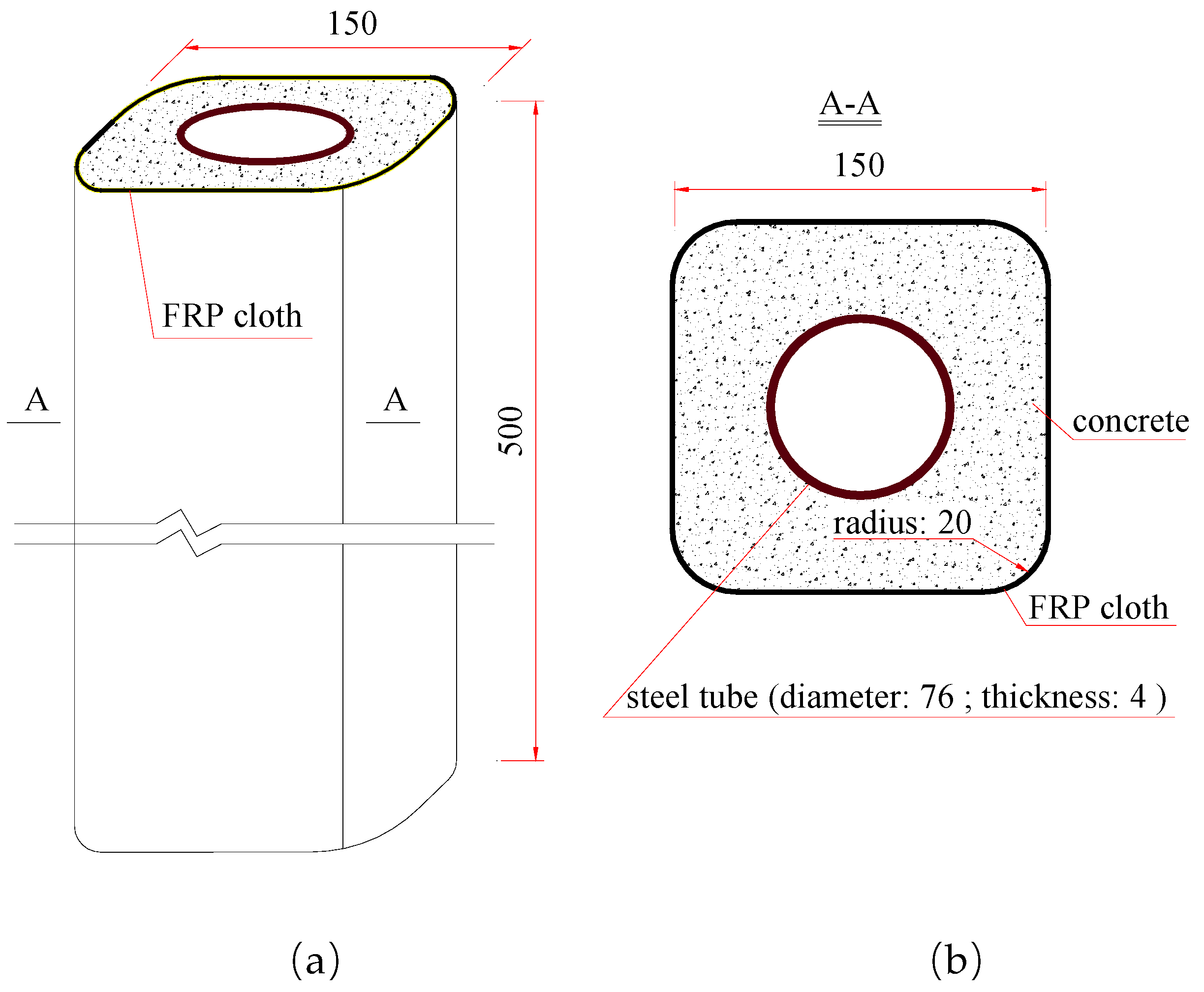
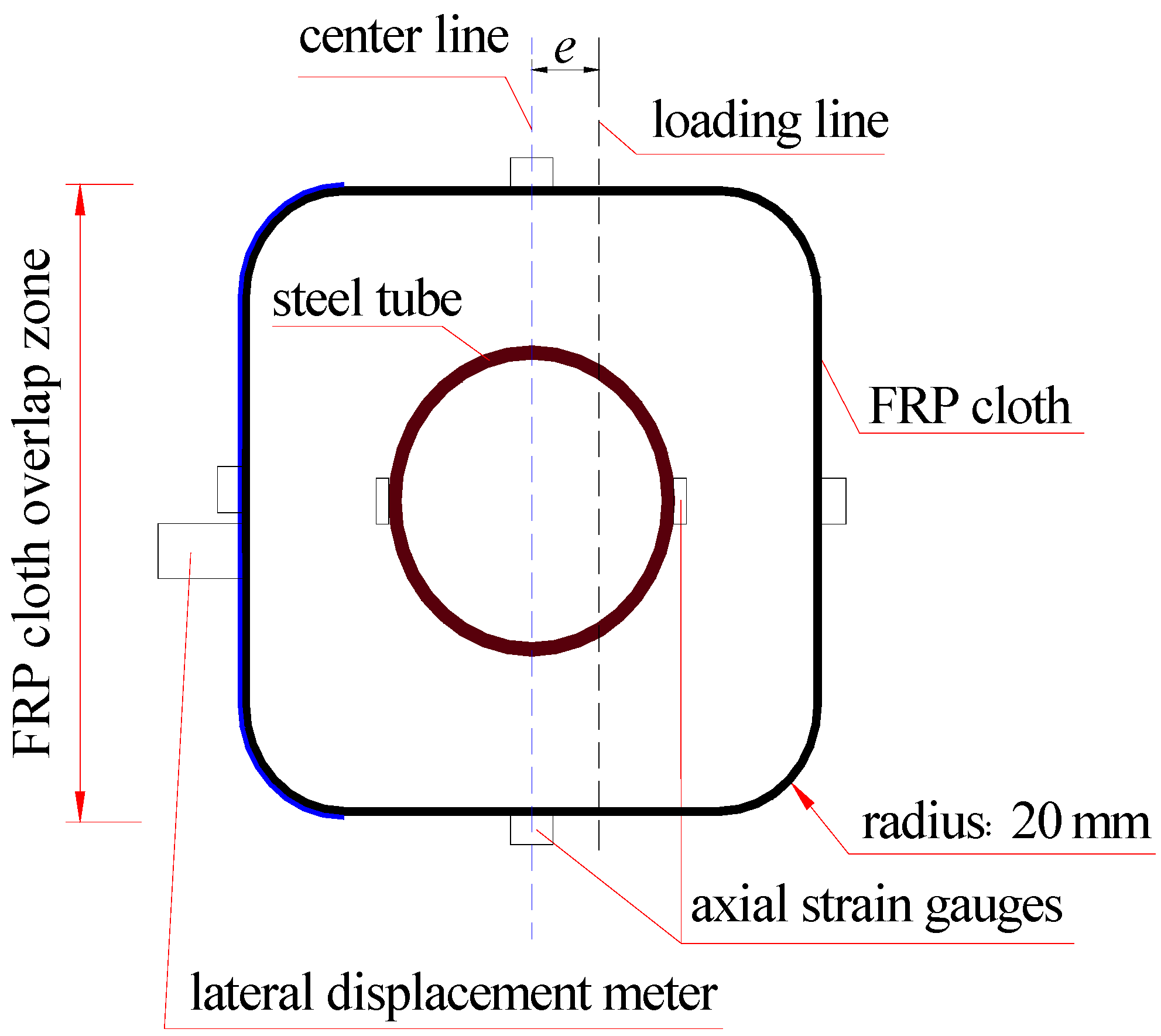

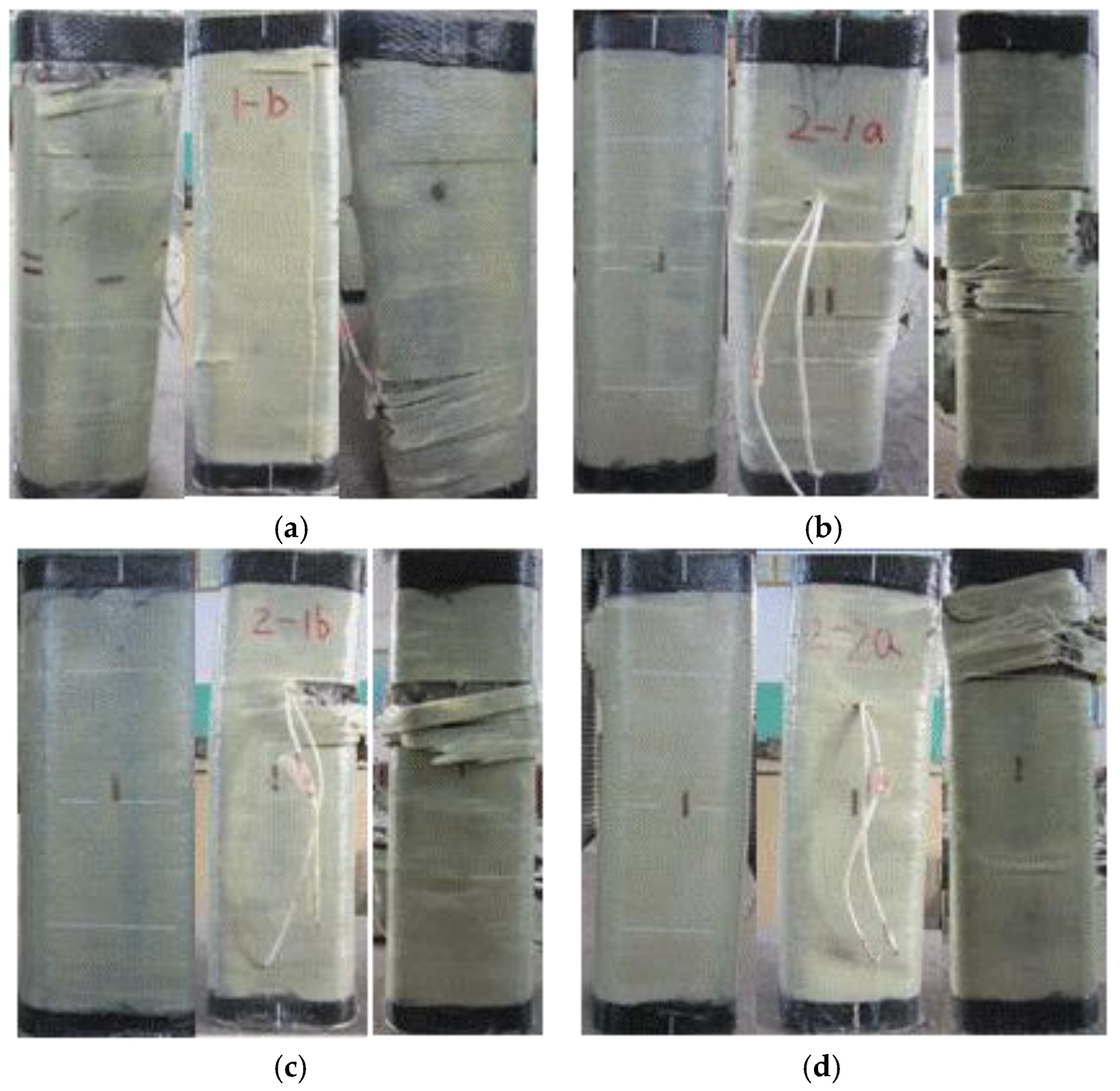

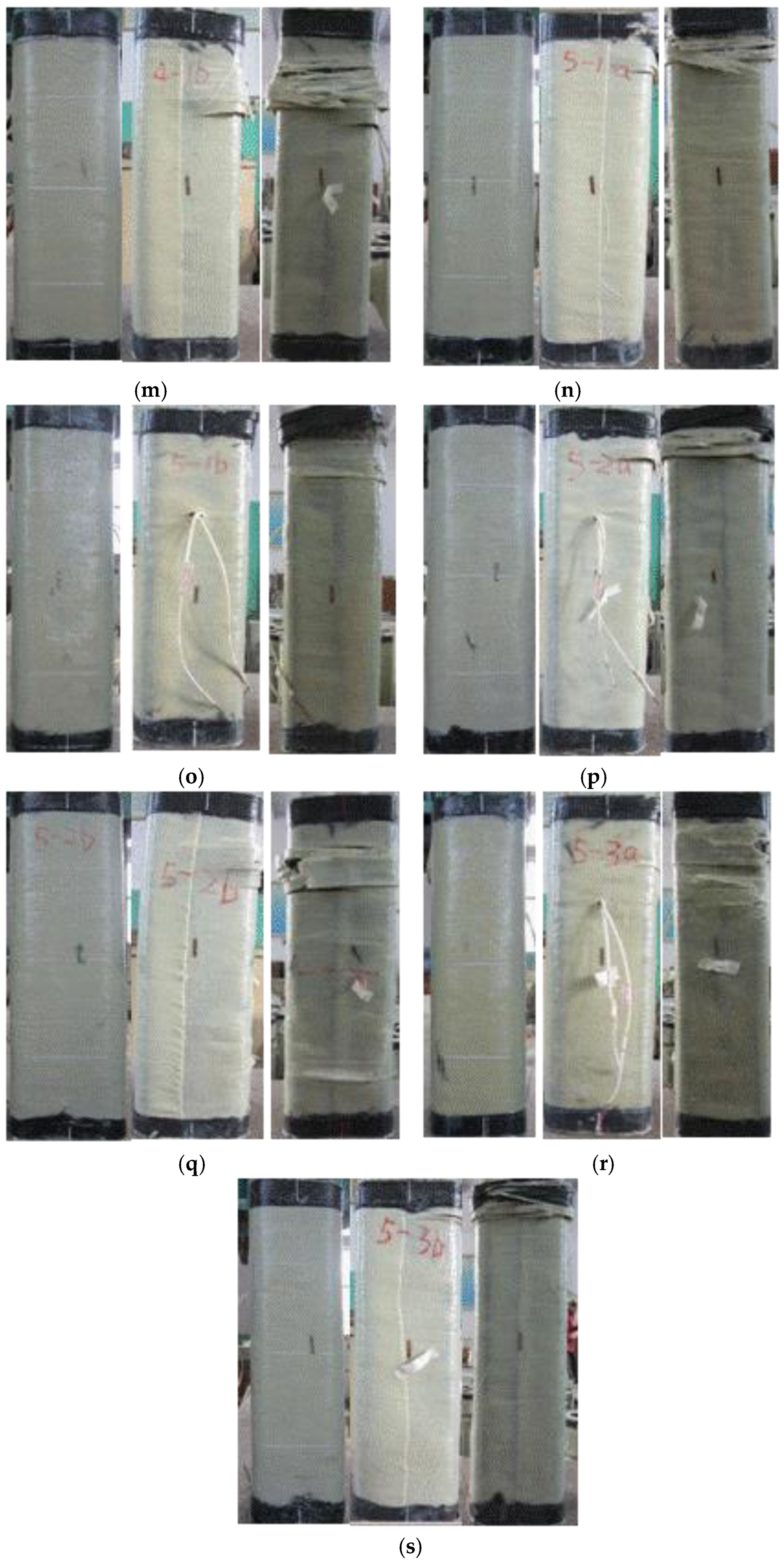
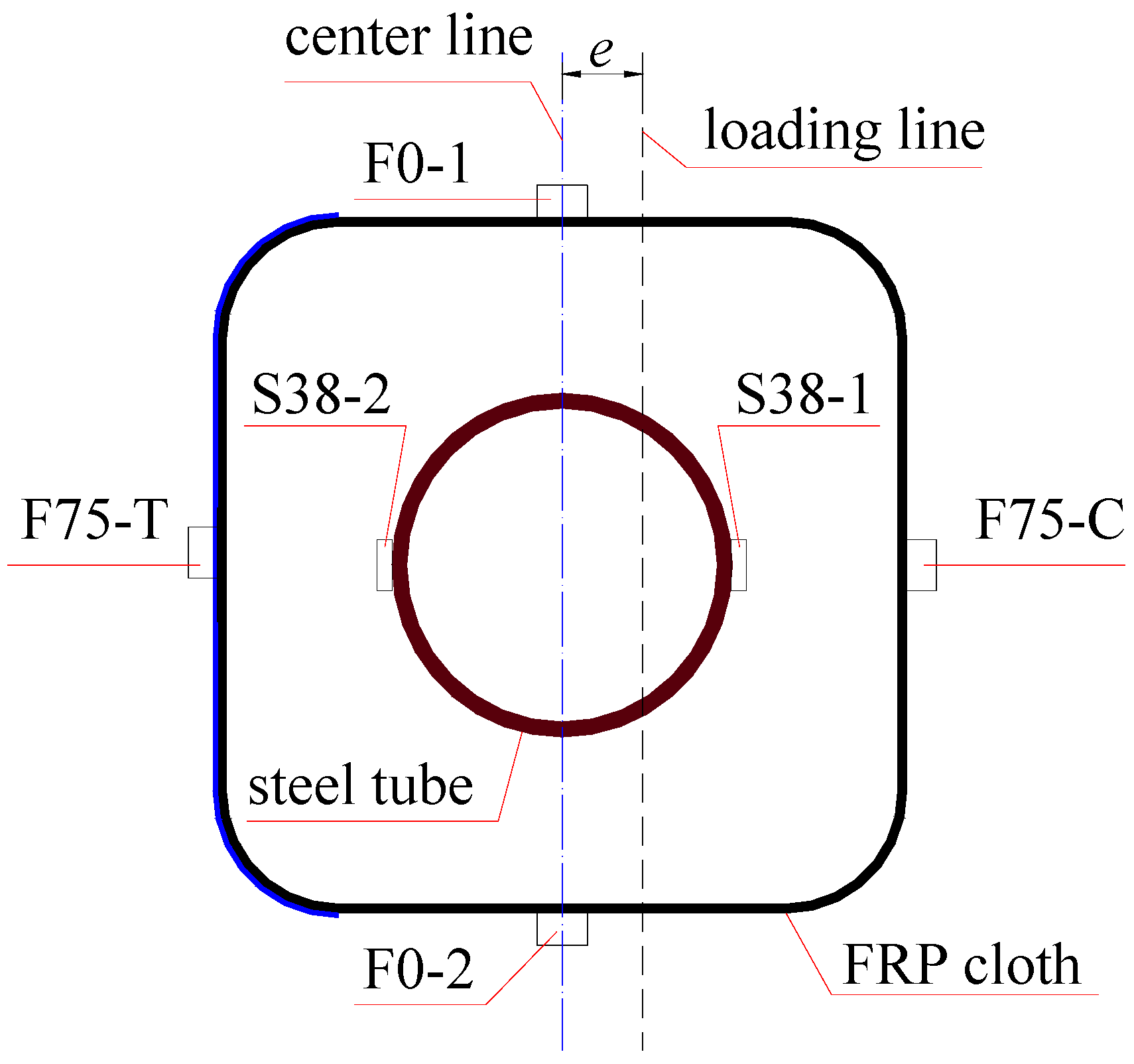

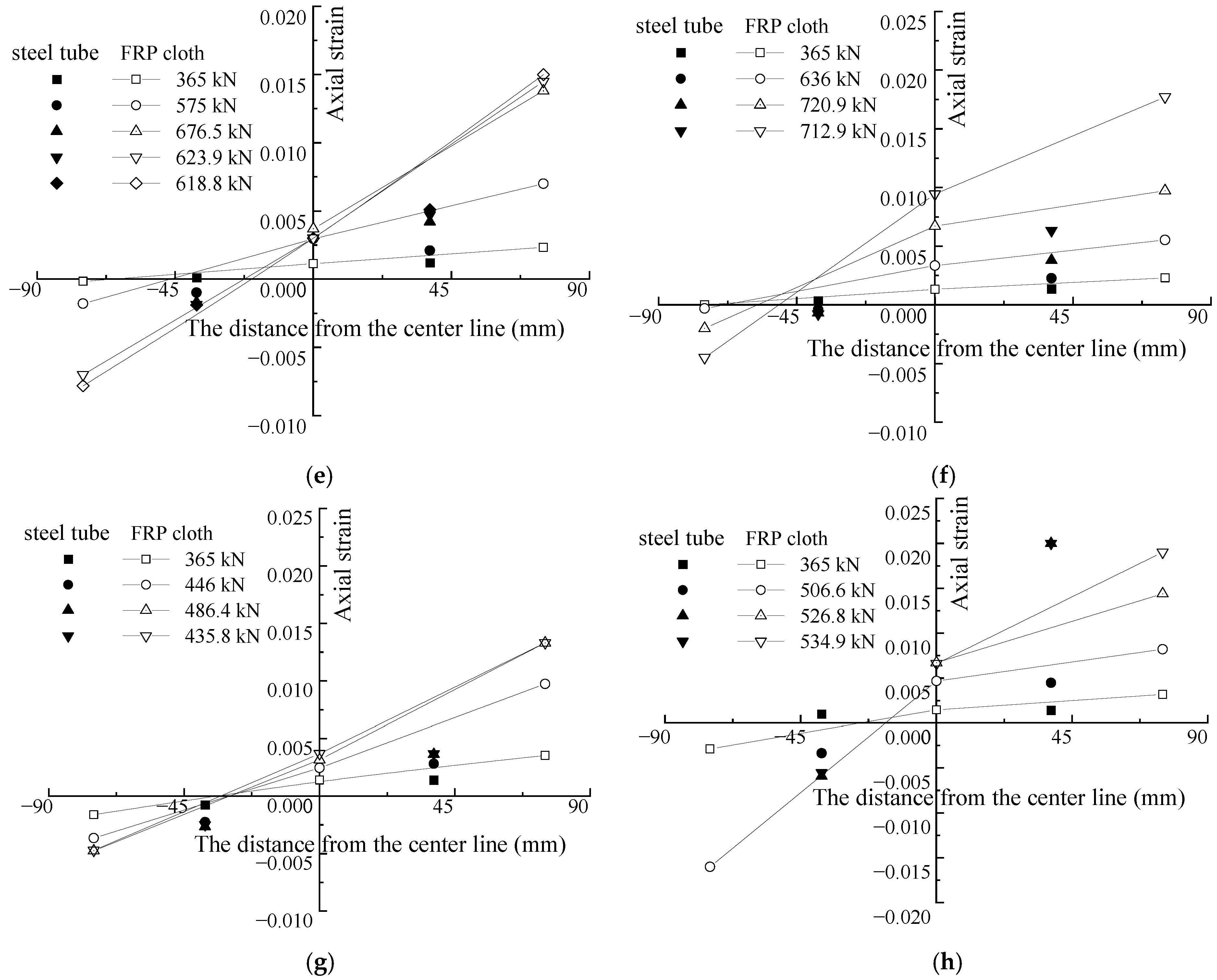
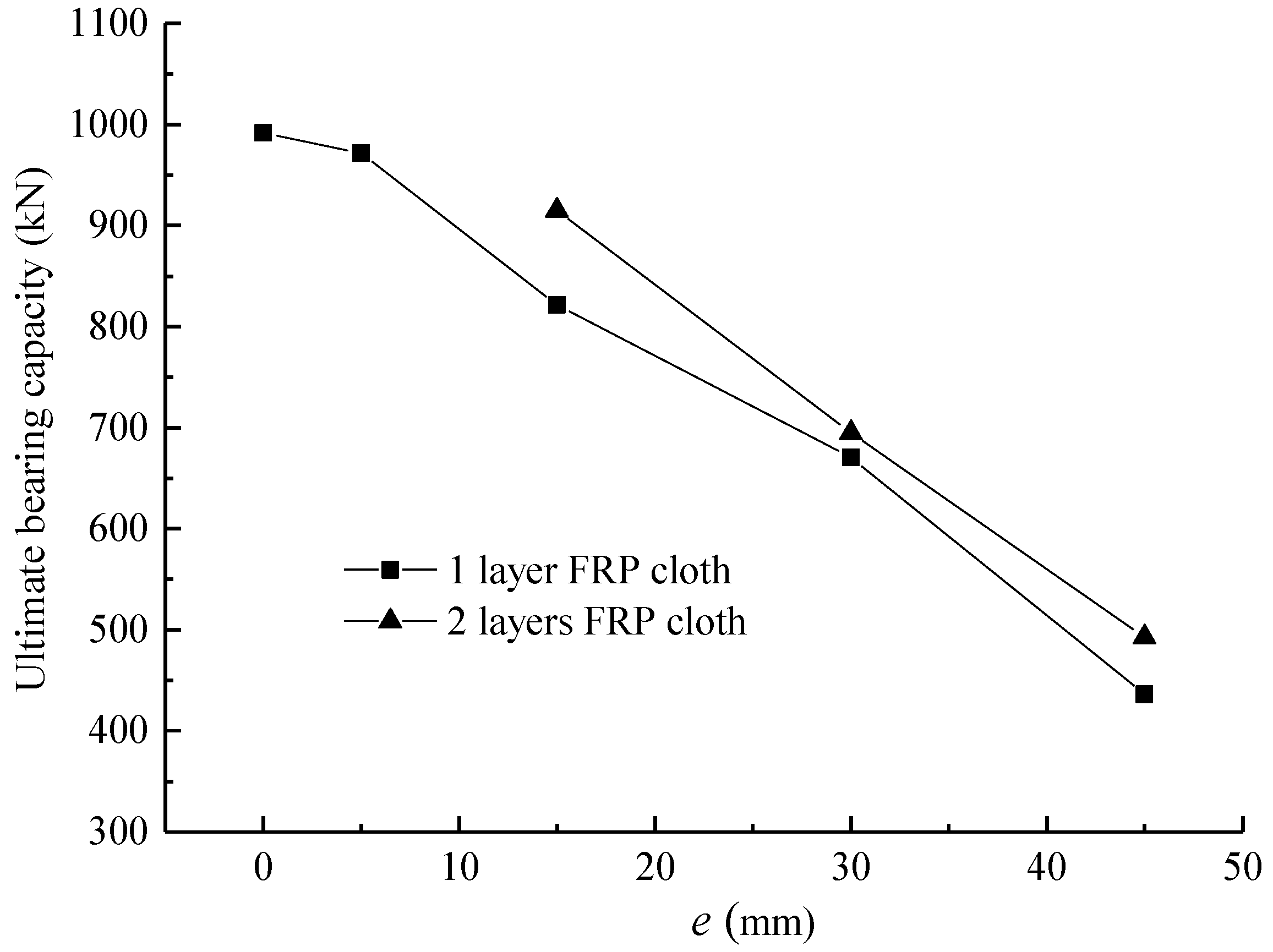


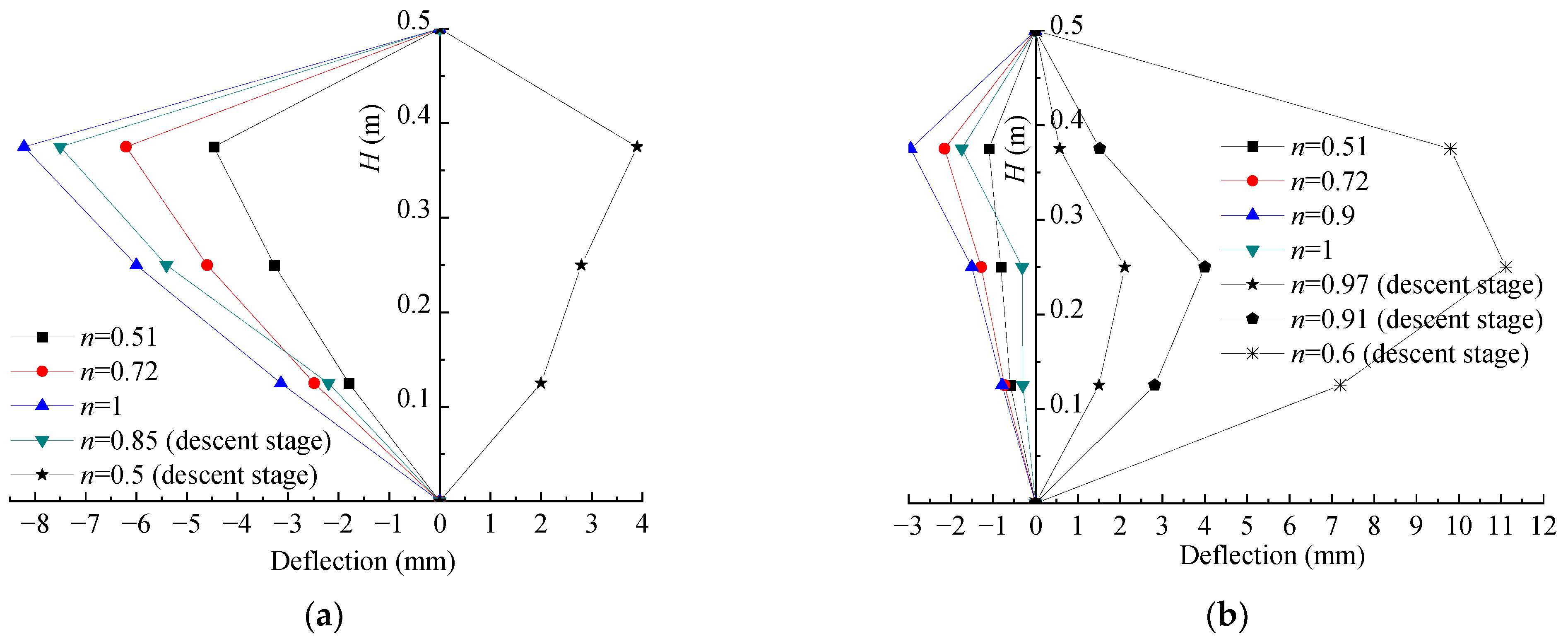
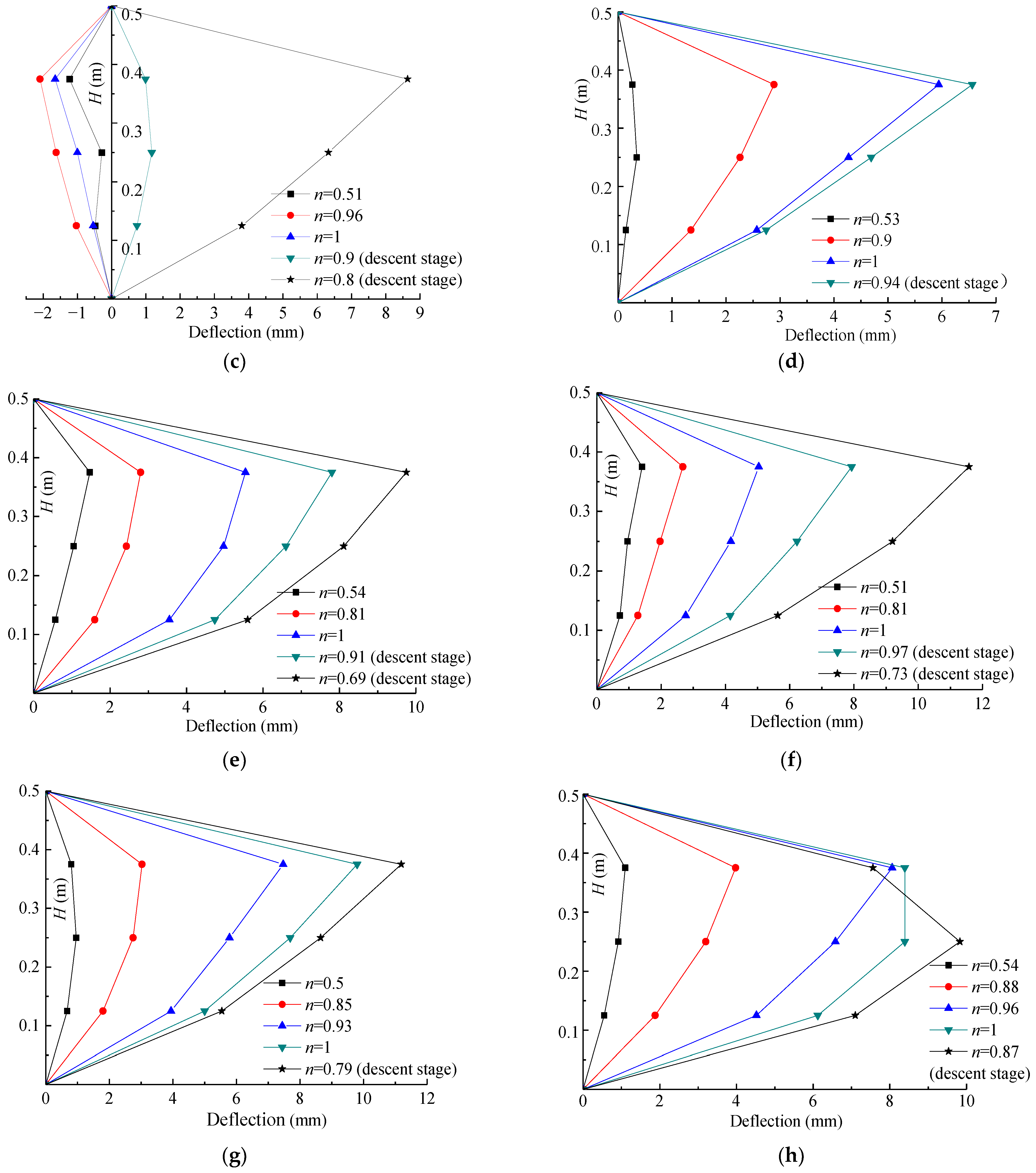
| Name 1 | Layers of Axial FRP 2 | Eccentricity (mm) | Strength of Concrete Cube (MPa) | Peak Load (kN) | Failure Mode 3 |
|---|---|---|---|---|---|
| A0E0 | 0 | 0 | 54.9 | 991.9 | ① |
| A0E5-a | 0 | 5 | 53.6 | 1068.8 | ② |
| A0E5-b | 0 | 53.9 | 1040.5 | ② | |
| A1E5-a | 1 | 55.8 | 1032.4 | ② | |
| A1E5-b | 1 | 52.7 | 911.0 | ② | |
| A1E15-a | 1 | 15 | 50.6 | 886.8 | ② |
| A1E15-b | 1 | 56.4 | 761.4 | ② | |
| A2E15-a | 2 | 54.4 | 971.7 | ② | |
| A2E15-b | 2 | 54.9 | 858.5 | ② | |
| A1E30-a | 1 | 30 | 55.3 | 664.3 | ② |
| A1E30-b | 1 | 53.0 | 676.5 | ② | |
| A2E30-a | 2 | 52.6 | 668.4 | ② | |
| A2E30-b | 2 | 57.1 | 720.9 | ② | |
| A1E45-a | 1 | 45 | 52.1 | 486.4 | ③ |
| A1E45-b | 1 | 49.9 | 385.3 | ③ | |
| A2E45-a | 2 | 48.3 | 450.0 | ③ | |
| A2E45-b | 2 | 50.8 | 534.9 | ② | |
| A3E45-a | 3 | 55.0 | 474.2 | ② | |
| A3E45-b | 3 | 56.9 | 425.7 | ③ |
Disclaimer/Publisher’s Note: The statements, opinions and data contained in all publications are solely those of the individual author(s) and contributor(s) and not of MDPI and/or the editor(s). MDPI and/or the editor(s) disclaim responsibility for any injury to people or property resulting from any ideas, methods, instructions or products referred to in the content. |
© 2023 by the authors. Licensee MDPI, Basel, Switzerland. This article is an open access article distributed under the terms and conditions of the Creative Commons Attribution (CC BY) license (https://creativecommons.org/licenses/by/4.0/).
Share and Cite
Wang, D.; Yuan, J.; Jing, J.; Fu, C.; Wang, Y.; Xiong, J. Eccentric Compression Properties of FRP–Concrete–Steel Double-Skin Square Tubular Columns. Polymers 2023, 15, 2642. https://doi.org/10.3390/polym15122642
Wang D, Yuan J, Jing J, Fu C, Wang Y, Xiong J. Eccentric Compression Properties of FRP–Concrete–Steel Double-Skin Square Tubular Columns. Polymers. 2023; 15(12):2642. https://doi.org/10.3390/polym15122642
Chicago/Turabian StyleWang, Dai, Jiansong Yuan, Jiahua Jing, Chengrui Fu, Yuhang Wang, and Jiaru Xiong. 2023. "Eccentric Compression Properties of FRP–Concrete–Steel Double-Skin Square Tubular Columns" Polymers 15, no. 12: 2642. https://doi.org/10.3390/polym15122642
APA StyleWang, D., Yuan, J., Jing, J., Fu, C., Wang, Y., & Xiong, J. (2023). Eccentric Compression Properties of FRP–Concrete–Steel Double-Skin Square Tubular Columns. Polymers, 15(12), 2642. https://doi.org/10.3390/polym15122642






